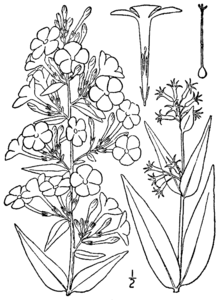Phlox maculata
Appearance
| Phlox maculata | |
|---|---|

| |
| Scientific classification | |
| Kingdom: | Plantae |
| Clade: | Tracheophytes |
| Clade: | Angiosperms |
| Clade: | Eudicots |
| Clade: | Asterids |
| Order: | Ericales |
| Family: | Polemoniaceae |
| Genus: | Phlox |
| Species: | P. maculata
|
| Binomial name | |
| Phlox maculata L.
| |
Phlox maculata,commonlycalledmeadow phlox,[1]as well aswild sweet William[2]andmarsh phlox,[3][a]is aspeciesofflowering plantin thefamilyPolemoniaceae,nativethe eastern United States and introduced to eastern Canada.[2]It is aperennial.[4]
Growing to 2–3 ft (61–91 cm), this erect, clump-formingherbaceousperennialproduces clusters of fragrant, deep pink flowers in summer. The stiff stems are spotted red, hence the Latinspecific epithetmaculata.It prefers damp, well-drained soil in full sun. It is less prone topowdery mildewthan the relatedPhlox paniculata.[5]
The followingcultivarshave received theRoyal Horticultural Society'sAward of Garden Merit:
-
Botanical illustration
-
Botanical illustration
Notes
[edit]- ^"Marsh phlox"also refers toP. glaberrimaandP. kelseyi.
References
[edit]Wikimedia Commons has media related toPhlox maculata.
- ^James H. Locklear.Phlox: A Natural History and Gardener's Guide.Timber Press, 2011.p. 169.ISBN9780881929348
- ^abUSDA, NRCS(n.d.)."Phlox maculata".The PLANTS Database (plants.usda.gov).Greensboro, North Carolina: National Plant Data Team.Retrieved13 November2017.
- ^Alan Branhagen.Native Plants of the Midwest: A Comprehensive Guide to the Best 500 Species for the Garden.Timber Press, 2016.p. 359.ISBN9781604697773
- ^"Phlox maculata".Native Plant Database.Lady Bird Johnson Wildflower Center,University of Texas at Austin.
- ^"Phlox maculata".Missouri Botanical Garden.Retrieved8 February2021.
- ^"Phlox maculata'Alpha'".RHS.Retrieved18 January2021.
- ^"Phlox maculata'Natascha'".RHS.Retrieved18 January2021.
- ^"Phlox maculata'Omega'".RHS.Retrieved18 January2021.



